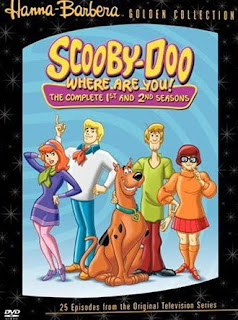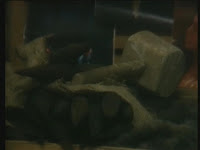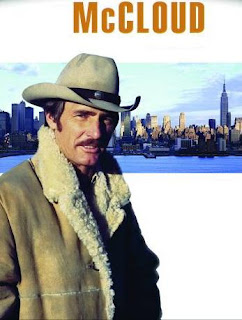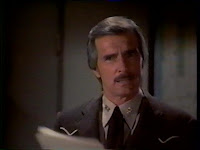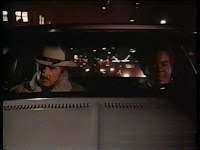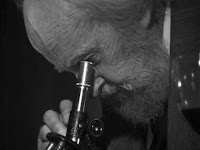First aired: 1969
Contains spoilers
It is odd to realise that this cartoon, which was part of my childhood, is actually that little bit older than I. This is real old school Scooby Doo, indeed from the first season of the first series.
It is a little unusual and I’ll be spoiling the mystery to explain why.
 The show starts with a view of Franken Castle and looking out over the countryside is a werewolf. He spots the Mystery Machine in the distance. The gang are actually travelling to the castle, which is the only one ever imported stone by stone from Transylvania. Mention is made of werewolves, they spot a caravan close by.
The show starts with a view of Franken Castle and looking out over the countryside is a werewolf. He spots the Mystery Machine in the distance. The gang are actually travelling to the castle, which is the only one ever imported stone by stone from Transylvania. Mention is made of werewolves, they spot a caravan close by. The caravan is offering fortune telling and so they stop. The gypsy is unnamed but I believe was meant to be called Carlotta. She warns them of danger, if they stay in the area, from the world of the dead. When they mention the castle she informs them that the caretaker ran away, that very day, as he believed the place to be haunted. Daphne (Stefanianna Christopherson) suggests they don’t go and Shaggy (Casey Kasem) agrees – “those werewolf cats come out like tonight, when the moon is full” (which is a bit of an oxymoron, if you think about it). They have a look-see anyway.
The caravan is offering fortune telling and so they stop. The gypsy is unnamed but I believe was meant to be called Carlotta. She warns them of danger, if they stay in the area, from the world of the dead. When they mention the castle she informs them that the caretaker ran away, that very day, as he believed the place to be haunted. Daphne (Stefanianna Christopherson) suggests they don’t go and Shaggy (Casey Kasem) agrees – “those werewolf cats come out like tonight, when the moon is full” (which is a bit of an oxymoron, if you think about it). They have a look-see anyway. The drawbridge is up and lightning rips the skies though there are no clouds (this effect is not explained). The drawbridge comes down and they start across (on foot) when a vampire appears and tells them to stop as they are not welcome there. He then fades and a bat swoops out at them. The drawbridge starts to lift again and the gang get back to the other side of the moat – that is all bar Daphne who is trapped.
The drawbridge is up and lightning rips the skies though there are no clouds (this effect is not explained). The drawbridge comes down and they start across (on foot) when a vampire appears and tells them to stop as they are not welcome there. He then fades and a bat swoops out at them. The drawbridge starts to lift again and the gang get back to the other side of the moat – that is all bar Daphne who is trapped. Not only is she stuck but Frankenstein Monster comes up behind her and chases her further into the castle. Freddy (Frank Welker) lassos a gargoyle and has Shaggy and Scooby Doo (Don Messick) swing across so that they can lower the drawbridge. They release the locking mechanism but are chased off by the werewolf, leaving Freddy and Velma (Nicole Jaffe) looking for their lost friends.
Not only is she stuck but Frankenstein Monster comes up behind her and chases her further into the castle. Freddy (Frank Welker) lassos a gargoyle and has Shaggy and Scooby Doo (Don Messick) swing across so that they can lower the drawbridge. They release the locking mechanism but are chased off by the werewolf, leaving Freddy and Velma (Nicole Jaffe) looking for their lost friends. Now I said that this was somewhat unusual and it is not just in how uncharacteristically brave Shaggy and Scooby were – yes they ran but they took very little persuading to swing across and actively set traps – Scooby even chases down the villain. It is more in the fact that there is only one villain and that villain, Big Bob Oakley (aka the actor), plays all of the monsters and Carlotta as he searches for treasure. I would have at least expected henchmen in some of the outfits. He is recognised by the sheriff who arrives as Scooby catches him (having been told of strange goings on by the caretaker) and is wanted in seven states.
Now I said that this was somewhat unusual and it is not just in how uncharacteristically brave Shaggy and Scooby were – yes they ran but they took very little persuading to swing across and actively set traps – Scooby even chases down the villain. It is more in the fact that there is only one villain and that villain, Big Bob Oakley (aka the actor), plays all of the monsters and Carlotta as he searches for treasure. I would have at least expected henchmen in some of the outfits. He is recognised by the sheriff who arrives as Scooby catches him (having been told of strange goings on by the caretaker) and is wanted in seven states. The treasure he is looking for is sewn into a tapestry and a message left by Franken in 1668 mentions fooling them all and being as rich as King Tut – an anachronistic line one feels. We wonder how the castle was moved from one continent to another without anyone noticing the jewel encrusted tapestry, why Oakley had to dress up as three different monsters (never actually named, but obviously based on the great Universal triumvirate), why he cross-dressed as a gypsy or indeed how he vanished from within a tomb (presumably via an unnamed and unfound, by th gang, secret passage)? These mysteries are never answered but the presence of the bat is answered, it was stuffed and on a wire.
The treasure he is looking for is sewn into a tapestry and a message left by Franken in 1668 mentions fooling them all and being as rich as King Tut – an anachronistic line one feels. We wonder how the castle was moved from one continent to another without anyone noticing the jewel encrusted tapestry, why Oakley had to dress up as three different monsters (never actually named, but obviously based on the great Universal triumvirate), why he cross-dressed as a gypsy or indeed how he vanished from within a tomb (presumably via an unnamed and unfound, by th gang, secret passage)? These mysteries are never answered but the presence of the bat is answered, it was stuffed and on a wire.Yet whilst this failed to answer more than it actually raised as questions it was great fun and pure Scooby in essence. 6 out of 10.
The episode’s imdb page is here.

